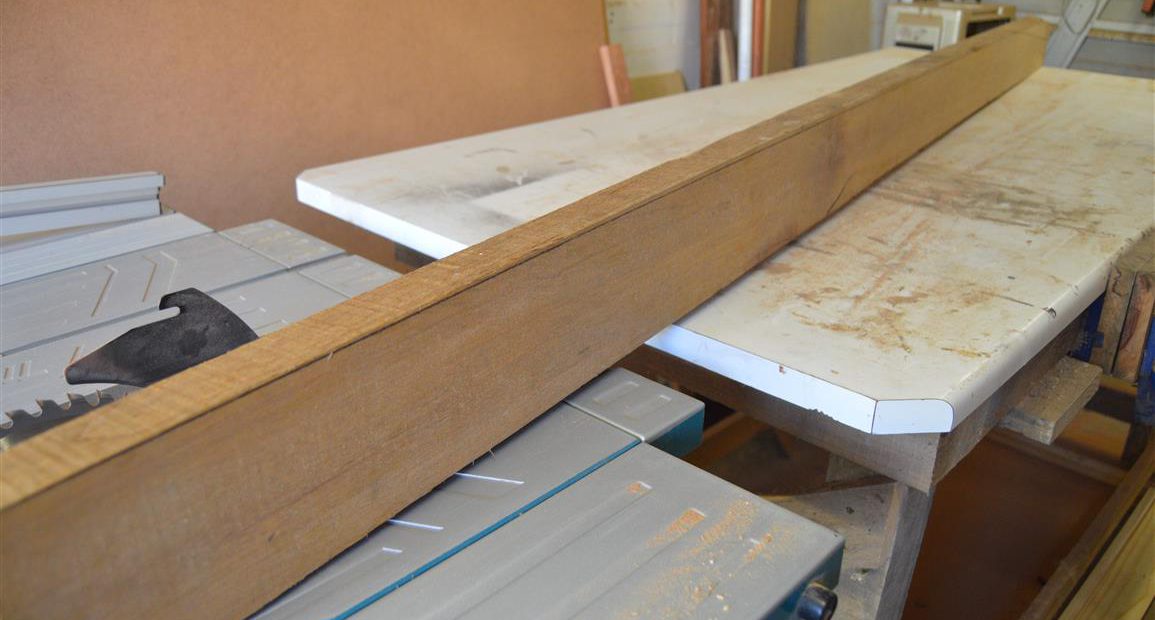Simplest squaring of rough cut lumber using a table saw

On the odd occasion, the component on your table saw that is largely responsible for its impressive accuracy becomes obsolete.
These are situations where you need to rip a piece of lumber with rough-cut or uneven edges.
The fence on your table saw is a huge asset in your tool arsenal but when the lumber to be cut does not have a straight edge to use as a reference the fence loses its usefulness.
In fact, all woodworking equipment that is operated with the use of a fence requires straight edged lumber running alongside it to work effectively.
So what to do if you’ve gotten your hands on some great lumber but unfortunately the edges aren’t true?

True cuts on rough lumber
Often people build proper jigs that allow them to clamp down the wood and then feed it straight through their table saws. In these cases, however, the jigs are more or less the same length, or even longer, than the stock that needs cutting.
In the case of these photos, the lumber is roughly 2m (6.5 ft) long.
This poses a problem for people like myself that don’t have the space to store a 6 ft jig just to whip it out on the ever so rare occasion when a piece of rough lumber finds its way into our shops.
Instead, I make use of a simple technique that delivers very close to, if not exactly the same result. A technique that will work for making straight cuts on rough edges, squaring boards, or pretty much any situation where you need to make a table saw cut on a piece of wood that does not have a straight edge to be used as a reference.
This super simple technique involves attaching a piece of wood with a true edge to the piece that needs cutting and then using that piece to guide your rough stock along the fence.

To do this you can purchase an inexpensive piece of PAR’ed pine or rip a piece of plywood wide enough to have a slight overhang when attached to the top of the rough lumber. The overhang will be the area in contact with the fence.
Using a wider plank is also important to prevent sideways deflection while feeding as you will only be attaching the guide plank to the rough lumber at the far ends.
In the case of my table saws fence, just placing a guide piece on top of the rough lumber would not result in adequate contact with the fence. Therefore I attached an additional plank at a 90° angle to increase the area in contact with the fence. This would not be necessary if the guide plank makes full contact with the fence but is still advised as it further prevents any deflection of the guide.
The guide is attached to the rough lumber using screws at the far ends only.
It is also important to attach the guide to the rough lumber in a way that will ONLY allow cutting of the rough stock and not the guide plank. The reason for this is so that the blade does not by accident contact the screws used to attach the guide to the stock.
Once the guide is attached to the rough stock you can use your table saw to make a true cut in the wood.

The guide will only be necessary to make the first cut. It can then be removed and the now straight edge can be used as a reference to cut the opposing edge.
The ends of the stock can be chopped with a miter saw to produce a square piece of lumber.
The guide can be re-used as much as needed before using the wood for whatever else you may find it useful for.




What kind of sandpaper should I use with wood like this?
Hi Nigel,
I’m afraid I’m not quite sure what you are referring to as the article is about using a table saw with rough lumber.
If you mean what grit sandpaper would work best with rough cut hardwood, it all depends on your desired result.
Hardwood is generally more resistant to sanding. What I find to work the best is to start with a low grit (60) and work my way up to higher grits in stages until my desired result is achieved.
I hope this is helpful.
Please feel free to correct me if I have misunderstood the question.
Jean
Super helpful, thanks! Getting my first table saw soon and recently found your YouTube channel. Great content!